Broken rice under the ban: India restricts grain exports
Broken rice from India is temporarily not available on the world market
The global agricultural market is experiencing a decline in food stocks. The main reasons for this are the geopolitical conflict in Europe and unfavorable weather conditions in many regions of the world. As a result, authorities of a number of countries limit export supplies in order to provide the necessary reserves for the domestic market. So did India, where the broken rice will not be sold to other countries for the time being. In addition, the authorities imposed a duty of 20% on other types of grain crops.
It should be noted that India is the world’s leading exporter of rice. The step on restriction carries serious consequences for importers, among which are Asian countries. In addition, other regions may also feel the difficulties. India accounts for about 40 percent of all global rice exports; last year it sold 21.5 million tons of grain to 150 countries. Thus, the country sold more volume than the total exported by Vietnam, and the U.S., and was ahead of Thailand, Pakistan, and the U.S., Thailand, and Vietnam in terms of supplies. The decision to limit the sale of the crop is due to a reduction in the country’s harvest. According to data, this year, rice production in India decreased by 5.6%, which was caused by insufficient rainfall during the ripening period of plants.
The decision to limit the sale of the crop is due to a reduction in the country’s harvest. According to data, this year, rice production in India decreased by 5.6%, which was caused by insufficient rainfall during the ripening period of plants.
Traditionally, July and August are important months for rice production in India. The amount of rainfall during this period determines the amount of rice planting. This year, the key Indian states for this crop have recorded 30-40% less rainfall than in previous periods. As a result, rice planting has been postponed, affecting overall yields. The government noted that during the monsoon season from June to October, rice production dropped by about 10-12 million tons. This in turn will result in a 7.7 percent reduction in the harvest.
This rice supply situation did not go unnoticed by stock markets. Despite the fact that prices for the crop had already remained at a high level, they began to rise in July, showing an increase of 9.3% year-on-year. The consumer price index suggests that inflation for rice was 3.6%, while last year it was in the 0.5% range.
According to experts, restrictions on broken rice exports will primarily negatively affect the market in the Philippines and Indonesia. For example, the Philippines imports 20% of the total consumption of rice, and the share of this crop in the food basket of the population is 25%. Indonesia buys 2.1% of its domestic market needs, and rice accounts for 15% of the food basket.
Other Asian states will also feel the effects of the restrictions imposed by India, primarily through higher product prices.
